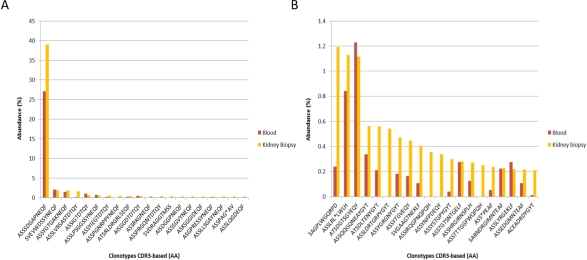Analysis of T Cell Receptor Repertoire in Routine Renal Allograft Biopsy.
1Department of Nephrology, Medical University of Vienna, Vienna, Austria
2Bioinformatics Research Group, University of Applied Sciences Upper Austria, Hagenberg, Austria.
Meeting: 2016 American Transplant Congress
Abstract number: A179
Keywords: Genomics, Kidney transplantation, Rejection, T cell receptors (TcR)
Session Information
Session Name: Poster Session A: Kidney: Acute Cellular Rejection
Session Type: Poster Session
Date: Saturday, June 11, 2016
Session Time: 5:30pm-7:30pm
 Presentation Time: 5:30pm-7:30pm
Presentation Time: 5:30pm-7:30pm
Location: Halls C&D
Introduction: Diversity and clonality of the T cell repertoire of circulating and tissue-resident T-cells can be assessed by sequencing of recombined T cell receptor (TCR) genes. We tested the feasibility of TCR repertoire analysis in tissue samples from routine cylinder biopsies of renal allografts.
Methods: We included biopsy samples from 20 patients who were biopsied in the first month after transplantation. 10 patients had an acute T cell mediated rejection and 10 had no rejection. The rearranged T cell receptor beta (TRB) loci from T cells were amplified by multiplex PCRs based on Biomed-2 primer sets using gDNA as a template. Amplicon sequencing was done by bidirectional Next Generation Sequencing using Illumina Miseq. Data analysis was done in several steps: first, sequence alignment of the rearranged V(D)J region of the TRB loci by IMGT/HighV-QUEST; second, we used our IMEX software for estimating the clonality and the diversity of the aligned.
Results: The single most abundant T cell clonotypes in the kidney accounted for 0.28% to 38.9% of all T cell cells, respectively. No significant differences in T cell clonality and diversity were found between acute rejection and no rejection. Relative abundancies of T cell clonotypes from two patients with acute rejection can be seen in Figure 1: Patient A has a higher clonalization of the repertoire than patient B.

Conclusion: We demonstrated that tissue-resident T cell receptor repertoire can be characterized in samples from routine needle biopsies. Clonality and diversity of T cells in biopsies with acute rejection were heterogeneous. Subtype identification is needed to determine function of the T cells. In a forthcoming trial we use mixed lymphocyte reactions to select alloreactice T cell clones to generate a unique fingerprint of the donor-reactive T cell repertoire prior to transplantation. Immune repertoire profiling of T cells in biopsy samples allows us to trace, quantify and characterize donor reactive T cells in the transplant.
CITATION INFORMATION: Reindl-Schwaighofer R, Weinberger J, Jimenez-Heredia R, Sunzenauer J, Schaller S, Winkler S, Oberbauer R. Analysis of T Cell Receptor Repertoire in Routine Renal Allograft Biopsy. Am J Transplant. 2016;16 (suppl 3).
To cite this abstract in AMA style:
Reindl-Schwaighofer R, Weinberger J, Jimenez-Heredia R, Sunzenauer J, Schaller S, Winkler S, Oberbauer R. Analysis of T Cell Receptor Repertoire in Routine Renal Allograft Biopsy. [abstract]. Am J Transplant. 2016; 16 (suppl 3). https://atcmeetingabstracts.com/abstract/analysis-of-t-cell-receptor-repertoire-in-routine-renal-allograft-biopsy/. Accessed December 19, 2025.« Back to 2016 American Transplant Congress
